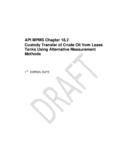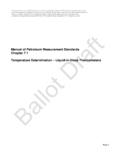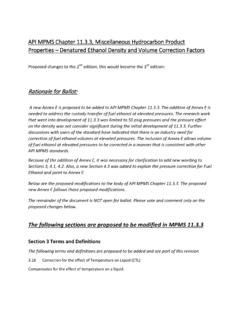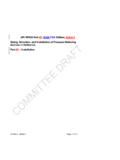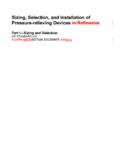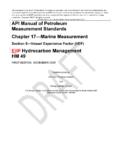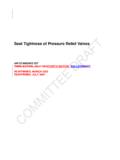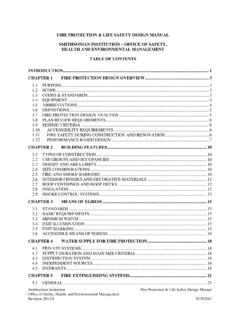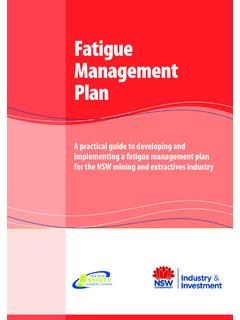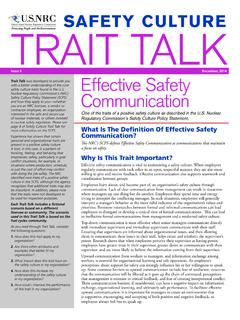Transcription of Contractor and Owner Safety Program Implementation
1 Contractor and Owner Safety Program Implementation API Recommended Practice 2221 Second Edition, august 2004 Draft Third Edition, xxxx 2011 Contractor and Owner Safety Program Implementation 1 Introduction General Many facilities in the refining and petrochemical processing industries employ Contractor personnel for a wide range of activities, from administrative support to equipment repair, maintenance, and construction. Contractor activities that involve work in or around process equipment can have an increased potential to place both Contractor personnel and Owner personnel at risk. Scope This guide is intended to assist refining and petrochemical industry facility owners and contractors implement (or improve) an effective Contractor Safety and health Program . In the petroleum segment, API RP 2221 applies to downstream activities only. This includes refineries, pipelines and marketing/distribution terminals but not exploration and production or marine.
2 This document provides guidance for applying the principles outlined in API RP 2220 Improving Owner and Contractor Safety performance . Security issues maintain a high profile in all aspects of industry, including the Contractor screening and selection process ; however, security is outside the scope of this standard and is mentioned as a reminder of the need for many facilities to include security in their Contractor processes. Introduction This publication intends to preserve the independent Contractor relationship while helping both owners and contractors improve Contractor Safety performance . It is based on experience in the petroleum and petrochemical industries and experience of firms that perform contract work for these industries. Since Owner facilities, equipment, sites and contracted work are diverse, this publication may not be applicable to operations at all facilities or to all contract work performed in these operations.
3 This publication may not apply to contractors working in low risk environments that generally do not affect facility Safety , such as those that provide incidental or supplementary services such as janitorial, beverage or laundry. Owner Commitment to Improved Contractor Safety performance The owners commitment and continued support of a health and Safety process are the essential elements of all successful Contractor Safety programs . Effective Contractor Safety programs require owners to focus resources on Safety and to maintain processes to review how Contractor Safety is being managed. To emphasize their commitment, many owners incorporate the need for Contractor Safety in senior management Safety , health and environmental policy statements. Contractor Commitment to Improved Safety performance The success of Contractor Safety initiatives requires commitment from the Contractor as an employer in addition to the commitment of facility owners.
4 Owners should encourage Contractor management commitment by sharing information regarding the success of effective health and Safety performance as cost-effective good business. PURPOSE The purpose of this publication is to assist owners and contractors to improve their Safety programs . Joint commitment and support of Safety Program initiatives are essential in minimizing incidents and preventing injuries and illnesses. The nature of the work performed by contractors within the petroleum and chemical industries varies greatly. Some contractors perform construction and turnaround activities; other specialty contractors provide skills and services that are not typically found within an Owner s work force. Other contractors may provide services to augment the peak loads and skills of owners work forces, such as in maintenance and operation of facilities. These diverse functions and uses of contractors share a common need for effective Safety programs to protect Owner and Contractor personnel from workplace injuries, illnesses and losses associated with incidents arising out of Contractor work.
5 This publication originated with an API task force comprised of representatives of Owner companies and contracting firms involved in downstream operations including refining, petrochemical, pipeline, wholesale marketing and distribution. Application of any section of this publication by management should take into account the type of work, the level of risk, and Safety performance expectations of the Contractor personnel. BENEFITS OF A Contractor Safety AND HEALTH Program Owners and contractors benefit when they work together to enhance the management of Contractor related Safety and health programs . These benefits include, but are not limited to: Improved Safety and health performance ; Better working relationship between Owner and Contractor ; Improved Safety and health training for both Owner and Contractor personnel; Improved quality and productivity; and Improved plant and equipment reliability.
6 Improved quality and productivity are inherent benefits because a comprehensive Contractor Safety Program requires that workers be properly trained for their job tasks and be familiar with their job requirements. Fewer incidents result in reduced regulatory inspections and provide for better control of project costs. The potential for damage to the Owner s facility and the Contractor s equipment is also reduced, thus improving productivity and reliability. Concept of Hazard vs Risk Hazards are conditions or properties of materials with the inherent ability to cause harm. Risk involves the potential for exposure to hazards that will result in harm or damage. For example, a hot surface or material can cause thermal skin burns or a corrosive acid can cause chemical skin burns, but these injuries can occur only if there is contact exposure to skin. A person working at an elevated height has stored energy and a fall from a height can cause injury but there is no risk unless a person is working at heights and is thus exposed to the hazard.
7 There is no risk when there is no potential for exposure. Determining the level of risk for any activity involves understanding hazards and estimating the probability and severity of exposure that could lead to harm or damage. While the preceding examples relate hazards to the risk to people, the same principles apply to property risk. For instance, hydrocarbon vapors in a flammable mixture with air can ignite if exposed to a source of ignition resulting in a fire which could cause injury and damage property. These concepts are significant in order to understand and properly define the categories of potential risk associated with work done by contractors. Contractor / Owner Relationship Contractor Safety and health programs are most effective when there is participation by both owners and contractors, each of whom has a distinct role in ensuring the ongoing Safety of Contractor activities. The Contractor / Owner relationship is significantly improved by clearly defining roles and responsibilities for both parties, establishing goals, objectives and expectations, and maintaining communication throughout the relationship.
8 This document, supplemented by extensive material in the appendices, provides approaches for implementing those responsibilities. Contractors frequently use subcontractors, both on large projects and for specialized work. Depending on the nature of the contract, a subcontractor is generally subject to the Owner s and/or Contractor s Safety and health requirements. The major difference between a Contractor and subcontractor is that a Contractor who employs subcontractors assumes the role of Owner with respect to the subcontractor. The Owner and prime Contractor need to discuss and agree on the Safety and health Program requirements for subcontractors during the pre-award process . Relationship to process Safety Management OSHA adopted 29 CFR process Safety Management (PSM) of Highly Hazardous Chemicals in 1992. Paragraph (h) of the OSHA PSM standard applies to contractors performing maintenance or repair, turnaround, major renovations, or specialty work on or adjacent to a covered process .
9 The OSHA PSM standard applies only to facilities that meet the relevant definitions. And, the PSM standard does not generally apply to contractors providing incidental services which do not involve or impact on process Safety , such as janitorial, laundry and other similar on-site services. The EPA also includes a Contractor Safety paragraph in their Risk Management Plan (RMP) regulation, that is similar to the OSHA PSM standard. This guide is general in nature and is not intended to provide, and does not provide, specific guidance for PSM compliance. However, elements in this guide may be of assistance in developing compliance programs for owners who have contractors working in facilities that are subject to the OSHA PSM or EPA RMP standard. 2 Referenced Publications The following referenced documents are indispensable for the application of this document. For dated references,only the edition cited applies.
10 For undated references, the latest edition of the referenced document (including any amendments) applies. General Safety standards appear in Annex N along with a bibliography of historical or useful references. General Safety standards appear in the final appendix along with a bibliography of historical or useful references. The following documents are referenced in this publication: API Security Guidelines for the Petroleum Industry, April 2003 RP 2220 Improving Owner and Contractor Safety performance API-NPRA Security Vulnerability Assessment Methodology for the Petroleum and Petrochemical Industries ASSE/ANSI Criteria for Best Practices in Safety , Health & Environmental Training NCCI ABC s of Revised Experience Rating DOT 49 Code of Federal Regulations (CFR) Parts 190 199 EPA Accidental Release Prevention Requirements: Risk Management programs Under the Clean Air Act, 40 CFR Part 68, Section 112(r)(7).
